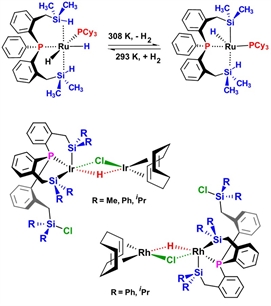OUR RESEARCH GROUP
State of art...
Research in our group concerns the Coordination Chemistry of Transition Metals bonded to novel ligands with the long-term research goal of contributing to the rational design of molecular catalysts for industrial processes from a fundamental chemistry approximation, that is, through the generation and study (experimental and theoretical) of novel coordination and organometallic complexes designed as homogeneous models for catalytic transformations.
Industrial development has greatly shifted towards the use of catalysts to the point that the majority of commercial chemical products involve catalytic processes at some stage of their production making them a multi-billion dollar business. By definition, catalytic reactions are recognized as environmentally friendly due to the reduced amount of reagents used and waste generated. However, owing to their physical/chemical complexity and the difficulties that in general haunt the study of reaction mechanisms, many catalytic cycles remain unsolved and their industrial implementation is mainly driven by empirical observations. One successful approach to elucidating catalytic mechanisms and thus to improve their efficiency is to employ transition metal molecular complexes in homogeneous phase as models.
Industrial development has greatly shifted towards the use of catalysts to the point that the majority of commercial chemical products involve catalytic processes at some stage of their production making them a multi-billion dollar business. By definition, catalytic reactions are recognized as environmentally friendly due to the reduced amount of reagents used and waste generated. However, owing to their physical/chemical complexity and the difficulties that in general haunt the study of reaction mechanisms, many catalytic cycles remain unsolved and their industrial implementation is mainly driven by empirical observations. One successful approach to elucidating catalytic mechanisms and thus to improve their efficiency is to employ transition metal molecular complexes in homogeneous phase as models.
Dual functionality phosphine ligands for transition metal complexation
Amongst the novel ligands we study, those incorporating both a group 14 element as well as a basic phosphorus atom in their structure have shown remarkable properties. Group 14 derivatives are exceptionally good sigma donors and exert a considerably high trans influence/effect, thus upon coordination they usually generate electron rich metal centers, which are in turn capable of activating otherwise inert substrates. In addition, the incorporation of phosphorous (and silicon or tin) in a ligand framework also allows for the employment of NMR spectroscopic tools. In the last years, the efforts of our research group have centred mainly on the design of pincer-like and tetrapodal phosphorous ligands functionalised with Si and Sn coordinated to second and third-row metals. We aim at extending our methodology to involve the coordination of cheaper, more environmentally-friendly first-row metals.

Homogeneous catalytic models
In particularly, our group wants to target catalytic dehydrogenative silylation (DHSi) and borylation (DHB) of alkenes to selectively synthesize unsaturated functionalized molecules (alkenyl-silanes and boranes) for a variety of applications. Other research groups around the world have targeted their synthesis making significant breakthroughs yet there remain large knowledge voids and central interrogations which must be addressed and fulfilled in order to improve selectivity, yield, reaction conditions, sustainability and substrate scope. Our research objective is to synthesize new catalysts of groups 8-10 transition metals (TM, and Mn) incorporating novel dual functionality Si-, Sn- or Ge- phosphine ligands.
The targeted unsaturated products, including for example vinylorganoboronic esters, are key building blocks and possess a wide variety of applications in industry and academia from material to life sciences. Amongst others, these applications are pharmaceuticals, polymers, cross-linking agents, rubbers and fine chemicals. In particular, the syntheses of the simplest vinyl compounds CH2=CHSiR3 and specially CH2=CHBR2 remain difficult challenges with scarce academic reports addressing them. We aim to generate them from catalytic DHSi or DHB from ethene.

